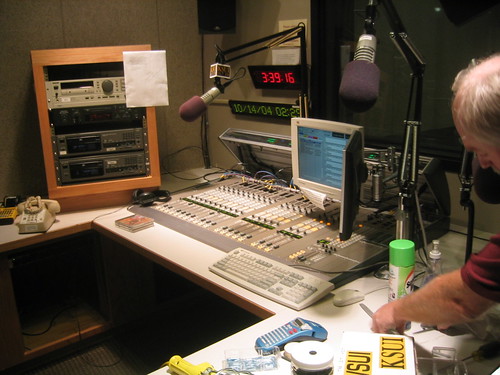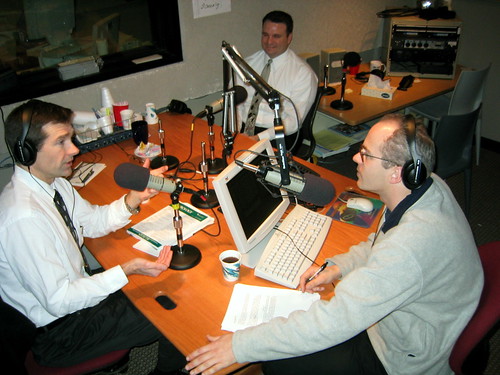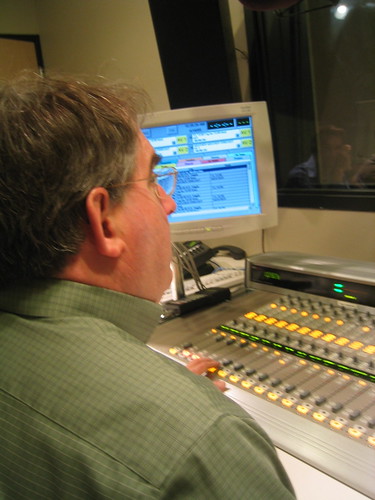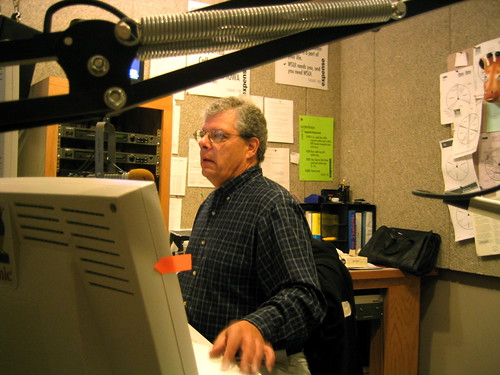 When I joined the world of public radio in 2003, the general manager for the group of stations that were controlled and funded by Iowa State University issued a white paper calling for the creation of a statewide network for public radio within the state. What he wanted to do was to bring all stations from the three major university’s into a single network, the other two school’s being the University of Northern Iowa and the University of Iowa.
When I joined the world of public radio in 2003, the general manager for the group of stations that were controlled and funded by Iowa State University issued a white paper calling for the creation of a statewide network for public radio within the state. What he wanted to do was to bring all stations from the three major university’s into a single network, the other two school’s being the University of Northern Iowa and the University of Iowa.
It was was in the first few days that this news came out of left field and made the whole place freak out. I was fresh to the whole public radio sphere at WSUI/KSUI, and it was within the first month of coming on board that people were telling me that I should consider applying for the full time position as assistant engineer. The thing is, no one knew if their jobs were going to be there if and when this consolidation took effect.
One thing that my time in college radio taught me was that bureaucracies work at an incredibly slow, painful, and sometimes ignorant pace. A motion like this would be a matter decided by a select group of people at the top of the institute of higher education food chain, the board of regents. It was no secret to anyone inside the stations that the guy who put out this white paper was licking his lips to be the one at the top of the organizational chart. Long story short, the process out-processed him. Not only did he not make it through the motions to be considered a finalist for the job, but he eventually left altogether.
Enter the era of the executive director of Iowa Public Radio, Cindy Browne. No matter how much everyone tried to put us at ease with the situation, there was never a worse feeling that treating this woman with ill manner would cost you your career. We were told that this wasn’t an era of consolidation, but an attempt at better cooperation. There would be an examining of how running all the stations under one network could save money, but anyone familiar with the way any media organization goes about such a venture knows what that means. The less people you have, the more money you can save.
 The common story of other statewide networks is a natural progression of binding together in times of need, and public radio finds themselves in that neighborhood quite often. One station merges with another station because of funding issues. As they get stronger, other nearby stations that are failing make last ditch efforts to exist on their own, only to find that consolidating with another, strong group of stations is the best decision. Once you have a big enough group with a good deal of coverage, a network is born.
The common story of other statewide networks is a natural progression of binding together in times of need, and public radio finds themselves in that neighborhood quite often. One station merges with another station because of funding issues. As they get stronger, other nearby stations that are failing make last ditch efforts to exist on their own, only to find that consolidating with another, strong group of stations is the best decision. Once you have a big enough group with a good deal of coverage, a network is born.
The one element that gets over looked in all of this is that all three of these university stations were not within the realms of experiencing major problems in the financial department. In their respective markets, everyone was existing but not rolling in revenue. This is a basic explanation of the state of things as the process was coming together.
Getting into ratings is a whole other topic, but those were not overly impacting in all of this as much as money was. In fact, if one were to discuss ratings, all that really mattered was competition between the three groups of stations. That’s not a bad thing. Loyalty within your own market, especially among a now failing Clear Channel world, has been shown to be a good thing. That small group of people sitting around a table in the state capitol, however, only concern themselves with where and how money is being spent, not local content.
 I left in the fall of 2005. That full time position never materialized because of the constant rollercoaster. Things were going to change, then they were going to stay the same, maybe there would be some shifting of staff, or there stood a chance that all of our programming was going to be relocated to come straight from Des Moines. No one knew, and a lot of the answers were closely guarded secrets. Media that’s funded by tax payers money, yet the public and staff were not told of what was to come of their stations. All I knew is that I did not want to move to the state capitol just to keep my job.
I left in the fall of 2005. That full time position never materialized because of the constant rollercoaster. Things were going to change, then they were going to stay the same, maybe there would be some shifting of staff, or there stood a chance that all of our programming was going to be relocated to come straight from Des Moines. No one knew, and a lot of the answers were closely guarded secrets. Media that’s funded by tax payers money, yet the public and staff were not told of what was to come of their stations. All I knew is that I did not want to move to the state capitol just to keep my job.
Today, the executive board of IPR is more rounded out with additional branches of administration. However, that era of cooperation is pretty much over. It wasn’t until I got a little curious the other day and started to check up on my old stomping grounds that I caught the changes that are to take place at the start of the new year.
From the IPR Blog:
From Three to One
Right now, we’re operating three separate News stations – AM640 in Ames, AM910 in Iowa City and 90.9FM in Cedar Falls. The stations have somewhat different schedules but for many hours of the day, they broadcast the same regional and national programs. We’re going to take the best programs on each station and create a unified news/talk service.
Unified is another way to say consolidated. Hosting duties have been appointed, programs are getting some shifting, and there is some question as to the people who are going to survive the change. The thing is, when you are a state employee, you can’t just be fired. There are a set amount of hoops you have to jump through as management, and only then can you eliminate a position. I won’t try to sound overly conspiratorial, but this does open up that door. I’ve already heard murmurs that there are some people there are already being questioned as to making it through this phase because you can only see this as the beginning.
 On a side note, the IPR website is something I have to take issue with. I say this not only from a design point of view, but for the fact that it is a perfect reflection of the organization as it currently stands. For nearly two years, the network has existed in name, but there is no branding or logo. It is a faceless entity that will control public radio for the entire state, and you get this feeling when you view “iowapublicradio.org“. There is nothing to make you feel good about the few select people in the state of Iowa that controls what you hear on the public radio airwaves in the region.
On a side note, the IPR website is something I have to take issue with. I say this not only from a design point of view, but for the fact that it is a perfect reflection of the organization as it currently stands. For nearly two years, the network has existed in name, but there is no branding or logo. It is a faceless entity that will control public radio for the entire state, and you get this feeling when you view “iowapublicradio.org“. There is nothing to make you feel good about the few select people in the state of Iowa that controls what you hear on the public radio airwaves in the region.
I do find it very wise that they have created a blog on the site. This is a very impressive decision on the board of directors part to extend some form of communication with the public. In the past few days, I’ve seen the amount of comments on the posts appearing on the site go up in numbers. It’s good to see that people are checking in, but I would be more inclined to see what people who are being directly affected by the decisions are saying. Of course, those who would speak out would stand the risk of being let go. That was something everyone was clued into early on.
 The common complaint about the UI group of stations was that we were, and I still declare myself apart of them in a sentimental way, making it a territorial battle, not wanting to be absorbed into this master plan. Some even called us stuck up, but it would be more valid to call us proud for the content we were working hard to produce. The truth is that we were amounting some momentum in quality, locally produced programming for our market, meanwhile being the least paid staff in the state.
The common complaint about the UI group of stations was that we were, and I still declare myself apart of them in a sentimental way, making it a territorial battle, not wanting to be absorbed into this master plan. Some even called us stuck up, but it would be more valid to call us proud for the content we were working hard to produce. The truth is that we were amounting some momentum in quality, locally produced programming for our market, meanwhile being the least paid staff in the state.
This is where I still find myself perturbed with the concept of Iowa Public Radio and the map they have laid out for the first of the year. A single stream of information for the entire state means less variety and less local content.
If this sounds familiar, you might be thinking of what Clear Channel has, and hasn’t, done for radio. As I type this, their massive consolidation venture is not as successful as the corporation would like and are in the process of selling numerous stations[wbjournal]. And look at the CBC; they are getting rid of their national television news program and replacing it with one-hour regional newscasts across Canada[cbc]. This is what the world of new media is doing to outlets across the board. Yet, IPR is moving towards that single stream model. And trust me, Iowa can be demographically ranging from one part of the state to the other, just like Canada can be across the country.
Maybe I’ll be surprised. Maybe things will turn out for the better. There is the argument that will be obvious as to the strength of radio in the future. I believe that it can still exist, but it has to be open to new ways to operate in this world of new media. Traditional forms need to be torn apart and rethought. People want local, variety, relevance, and some control. IPR will have the relevance to a point, but everything else starts to become lacking after that.
Update: Here’s a recent article about the IPR programming changes in the Des Moines Register from December 3rd, 2006. The reaction is what I expect, but I fear that there are far fewer people who know about what is to come. The major reaction won’t come until the beginning of 2007.
